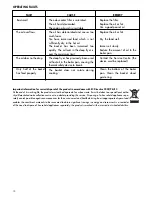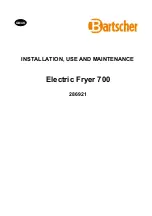
9
CHIPS
Recommended quantity
500
190
7-8
for excellent frying
MAX quantity (safety limit)
1000
190
14-16
FISH
Squid
500
160
9-10
Canestrelli
500
160
9-10
Scampi tails
600
160
7-10
Sardines
500-600
170
8-10
Cuttlefish
500
160
8-10
Sole (n. 3)
500-600
160
6-7
MEAT
Beef steak (n. 2)
250
170
5-6
Chicken steak (n. 3)
300
170
6-7
Meat balls (n. 8 - 10)
400
160
7-9
VEGETABLES
Artichokes
250
150
10-12
Cauliflower
400
160
8-9
Mushrooms
400
150
9-10
Aubergines
300
170
11-12
Courgettes 200
170
8-10
Type of food
Max. Quantity
Temperature °C
Time in Minutes
Bear in mind that the cooking times and temperatures are approximate and must regulated according to the
ammount of food which is to be fried and to personale taste.
FRYING NON-FROZEN FOOD
• Frozen foods have very low temperatures. As a
result they inevitably cause a considerable drop in
the temperature of the oil or fat. To achieve a good
result, we advise you not to exceed the quantities
recommended in the following table.
•
Frozen foods are often covered in ice crystals
which it is necessary to remove before cooking by
shaking the basket.
Then immerse the basket very
slowly into the frying oil to avoid the oil reboiling.
FRYING FROZEN FOOD
The cooking times are approximate and must be varied according to the initial temperature of the food which is to
be fried and according to the temperature recommended by the frozen food producer.
CHIPS
Recommended quantity
180 (*)
190
4-6
for excellent frying
MAX quantity (safety limit)
1000
190
16-18
POTATO STICKS
500
190
7-8
FISH
Cod fingers
300
190
4-6
GShrimps
300
190
4-6
MEAT
Chicken steak (n. 3)
200
180
6-8
Type of food
Max. Quantity
Temperature °C
Time in Minutes
WARNING: Before immersing the basket, check that the lid is firmly closed.
(*) This is the recommended dose to achieve excellent frying. It is naturally possible to fry a larger amount of fro-
zen chips, but you should bear in mind that in this case they will end up being a little greasier because of the
sudden drop in the oil temperature at the time of immersion.























